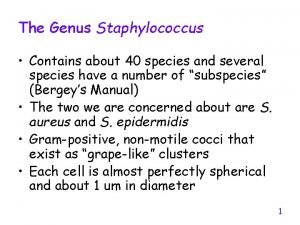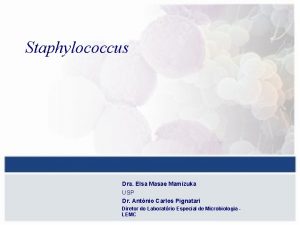Prevalence of Staphylococcus succinus and Staphylococcus equorum in

- Slides: 1

Prevalence of Staphylococcus succinus and Staphylococcus equorum in the Anterior Nares of Volunteers from the Loja Community of Ecuador Eryn Mares, Mellen Omweno | Faculty mentor: Dr. Dan Herman | Biology Department Introduction: Staphylococcus equorum and Staphylococcus succinus are bacterial species commonly associated with livestock including equine and avian species, also certain food products. Human infection as a result of these species is rarely reported and there are currently no reports citing these species as components of the normal human flora. During the summer of 2011, nasal swabs were taken from volunteers from hospitals and communities in Ecuador. This data set is composed of samples from volunteers of three Loja communities. Bacteria isolated from these samples were initially characterized using cultural methods. Isolates that were mannitol fermenters and oxacillin sensitive were further characterized using multiplex PCR and Xap. I restriction fragment length polymorphisms of the dna. J gene. Approximately 8% of samples analyzed thus far contain either S. succinus or S. equorum. These preliminary data suggest that these species can at least be transient members of the human nasal flora and can possibly be established as a more stable component. Methods: Bacterial Growth: Samples of the bacteria from nasal swabs that have been kept in a glycerol media at -80 degrees Celsius are inoculated into Mueller Hinton broth and incubated at 37 C overnight, then onto mannitol salt agar plates. A single colony is selected form the plate and again grown overnight in Mueller Hinton broth for DNA isolation. Colonies are also inoculated onto plates containing oxacillin to determine whether or not the species is resistant to oxacillin. Isolation of DNA: DNA is isolated from the cells using a lysostaphin based procedure (1). A spectrophotometer is then used to quantify the amount of DNA. Agarose gel electrophoresis is used to confirm the results of the spectrophotometer showing that DNA has successfully been isolated. Multiplex Polymerase Chain Reaction: A PCR mixture containing three primer pairs are used to amplify the 16 s r. RNA, fem. B, and mec. A genes (2). Agarose gel electrophoresis is used to separate the PCR products and the gel is imaged. This is used to confirm that the species are a type of Staphylococcus, Staphylococcus aureus, or Methicillin Resistant Staphylococcus aureus (MRSA). Restriction Fragment Length Polymorphism Analysis: The genomic DNA isolated is then used in an additional PCR to amplify a portion of the dna. J gene followed by a restriction enzyme Xap. I digest (1), and the fragments are separated on an agarose gel using electrophoresis. The pattern of fragments produced is unique to specific bacterial species and is compared to controls of known species for identification. Results: 1 2 3 4 5 6 7 8 9 10 11 12 13 14 Figure 1: Bacterial growth on mannitol salt agar plates. Color change from red to yellow indicates fermentation of mannitol and limits the study to mannitol fermenters. Figure 2: Multiplex PCR gel used to determine whether species are Staphylococcus, S. aureus, or MRSA. Lanes: 1 - 100 bp ladder. 2 - ICQ 103. 3 ICQ 104. 4 - ICQ 108. 5 - ICQ 109. 6 ICQ 115. 7 - ICQ 092. 8 - ICQ 101 -S. 9 ICQ 101 - L, 10 - ICQ 105, 11 - SA control. 12 - MRSA control Figure 3: Xap 1 digest gel for dna. J PCR product. Lanes: 1 - 100 bp marker. 2 - ICQO 67 3 - H 089. 4 - H 008. 5 - IBM 138. 6 ICQ 083. 7 ICQ 084. 8 - ICQ 117. 9 ICQ 118. 10 - ICQ 124. 11 - H 082. 12 H 087. 13 - H 107 14. SA control Figure 4: Graphs of characterized samples collected from three Loja Communities and a hospital in Ecuador. Discussion: Multiplex PCR was used to amplify the 16 s r. RNA gene, fem. B gene and mec. A gene in each sample. The results indicate all of the isolates belong to the genus Staphylococcus as demonstrated by the 16 s r. RNA band (Figure 2). S. aureus samples contained two bands at approximately 800 bp and 300 bp, showing the 16 s r. RNA and fem. B genes respectively. MRSA isolates showed an additional band at 150 bp representing the mec. A gene (Figure 2). dna. J PCR results showed the amplification of the dna. J gene in each of the samples. A restriction Xap. I enzyme digest was used to identify the species of the isolates (Figure 3). A total of 25 samples were analyzed during Spring 2018, and 12% of the isolates were found to be S. succinus such as sample ICQ 117 (Figure 3). This is consistent with the entire sample set as 11. 4% are S. succinus. S. eqourum were not present in the samples identified during Spring 2018, however, they were found in 1. 5% of samples within the total sample set. Although these results do not indicate that species besides MRSA have resistance to oxacillin, previous studies have shown antibiotic resistance in S. Succinus and S. equorum. Specifically, S. equorum has shown to be vancomycin resistant. Because S. equorum can reside in nasal mucosa and is living within close proximity of S. aureus, there is concern regarding whether or not the gene for antibiotic resistance could transfer into S. aureus. Further research could be done to create antibiotic susceptibility profiles for S. equorum and S. succcinus, as well as determining if genetic transfer between these species and S. aureus can occur. References: 1. Hauschild, T. , Stepanovic, S. 2008. Identification of Staphylococcus spp. By PCR-Restriction Fragment Length Polymorphism Analysis of dna. J gene. Journal of Clinical Microbiology, Volume 46, No. 12: 3875 -3879. 2. Jonas, D. , Speck, M. , Daschner, F. D. , Grundmann, H. 2002. Rapid PCR-Based Identification of Methicillin- Resistant Staphylococcus aureus from Screening Swabs. Journal of Clinical Microbiology, Volume 40, No. 5: 1821 -1823. 3. Novakova, D. , Sedlacek, I. , Pantucek, R. , Stetina, V. , Svec, P. , and Petras, P. 2006. Staphylococcus equorum and Staphylococcus succinus Isolated from Human Clinical Samples. Journal of Medical Microbiology 55: 523 -528. Acknowledgements: The University of Wisconsin Eau Claire’s Office of Research and Sponsored Programs for providing funding for this project .

